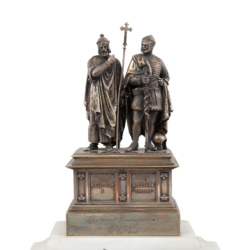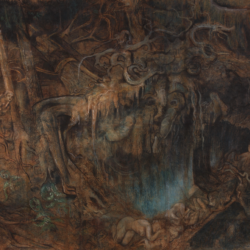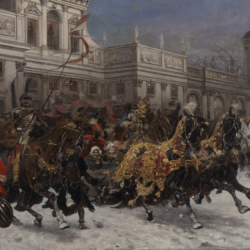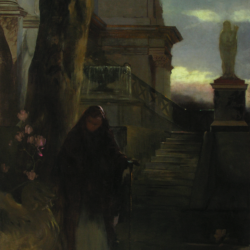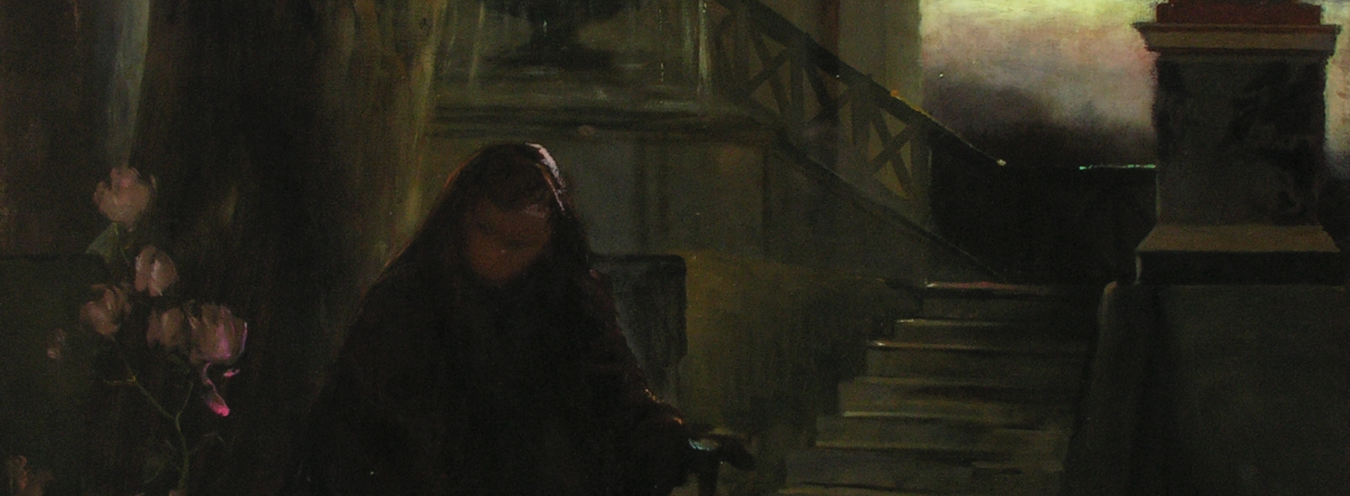
Sienkiewicz and the Lowly Ones: The Concept of the “Remnant”
A question that emerges here is how is political theology (as the reinstatement of the eschatological view of history) different from the theologically-oriented philosophy of history? Would it not suffice to classify Sienkiewicz as a “novelist with historiosophical aspirations”? The affirmative answer to the second question would not, however, make sense, since the positivist verdict on the writer’s lack of philosophical sophistication is by all means justifiable. In my opinion, the essential difference can be seen in the fact that political theology is to classic theology what algebra is to mathematics. In political theology, a concrete epiphany of the eschaton functions as an element in the system that underlies all organizational details of a given political reality, and in consequence – psychological and social realities as well. Thus, if we can speak of any specific intuition on the part of the author of the Trilogy, it would be religious and political (and the question about these particular gifts of Sienkiewicz would most likely get an affirmative answer). A good illustration of this understanding of the sign system for the transcendent order can be found in The Political Theology of Paul by Jacob Taubes, a philosopher of religion:
My thesis is that Paul understands himself as outbidding Moses. […] My thesis thus implies that Christianity has its origin not properly in Jesus but in Paul. That is the problem we’re dealing with here. And the argument for this thesis lies in the parallel between Moses and Paul. […] [The apostle – M.P.] wants to prove by means of Holy Scripture that now the moment has come to open up to the Gentiles. The opening of the Jews, of God’s holy people, to the Gentiles. And this holy people of God is transfigured, that is, the old people winds up becoming unclear.[1]
Taubes’s analysis of the letters of Saint Paul reveals not only the precedence of interpretation over the Eschatological Event itself (the epiphany of the coming Christ) but also the mental revolution of cultural and social nature that is actually brought about by this interpretation. According to Taubes, Saint Paul made this happen by coining a new concept that almost instantaneously became part of political reality with a potential to develop in time: namely, the notion of the “remnant” of Israel, an amorphous mass of individuals who had been blind to God’s Revelation to the Chosen People but were now ready to accept it under a new form. Taubes writes that Paul’s mission is “bringing in the Gentiles in order to make Israel jealous. He introduces the concept of the remnant and speaks of pas Israel. […] These are not rhetorical flourishes, but rather the devastation about the people of God no longer being the people of God.”[2]
The “remnant” – apparently, the key concept of the Christian cultural formation in the context of political theology – played an important role also in the mental and literary evolution of Sienkiewicz. Clues to this effect can be gathered from the novelist’s interests and the subject matter discussed in his works; for instance, historical narratives such as Tartar Captivity or With Fire and Sword (Ogniem i mieczem) are preceded by texts devoted to those rejected and marginalized in social relations. In his 1877 letter to actor, playwright, journalist, and critic Daniel Zgliński, Sienkiewicz expressed bitterness over the reviews of his Charcoal Sketches (Szkice węglem), tales about Polish common folk:
I keep hammering away at these unhealthy social relations, at the desperate, unacceptable, immoral, unnatural path of social ruin […]. I pick at a festering wound, Zołzikiewicz the rascal […], I give them the first peasant novel that does not portray some idealized rustic but a real-life “son of the soil” and his everyday existence – and they get it all wrong.[3]
Throughout his essay[4], Tadeusz Bujnicki deliberates whether it is well-founded to talk about any radical change of heart on the part of Sienkiewicz (the critic’s hesitancy is also indicated in the second part of the essay’s subtitle with putting the word “breakthrough” in shudder quotes). According to Bujnicki, the crux of the issue is that Sienkiewicz basically remained a positivist even after publishing the Trilogy. It could be added that there is a certain logical connection between Charcoal Sketches and, for example, Tartar Captivity, and its logic is best discussed in terms of political theology. Beyond intentional logic but within the messianic logic of theological nature, Sienkiewicz identifies the symbolic “remnant” in the Polish society of his time: the most important characters in his earlier works are representatives of the peasantry and gentry who unswervingly uphold the national tradition and Christian religion, and the consecutive parts of the Trilogy portray clean-cut noble-born characters. Sienkiewicz’s message is not just that the strength and future of the nation are dependent on the recovery of leadership by the “morally renewed” nobility, as a conservative would typically argue. Instead, Sienkiewicz intimates that the historical dynamics of the Polish society’s evolution would from then on be determined by moral imitation and emulating the qualities of protagonists (such as knights Kmicic [Kmita] and Wołodyjowski [Volodyovski]) by people up till then deprived of any say or recognition (such as Wawrzon Rzepa, a peasant).
Przypisy
- J. Taubes, The Political Theology of Paul, translated by D. Hollander, Stanford, California, 2004, pp. 39–41.
- Ibidem, p. 38.
- Quoted in T. Bujnicki, Pierwszy okres twórczości Henryka Sienkiewicza [Henryk Sienkiewicz’s early writings], Kraków 1968, p. 110; trans. J. M.
- See T. Bujnicki, “Sienkiewicz przekracza granice. O „przełomie” w życiu i twórczości pisarza” [Sienkiewicz pushing back boundaries: About ‘the turning point’ in the life and works of the writer], Wiek XIX. Rocznik Towarzystwa Literackiego im. Adama Mickiewicza 2009, vol. 2, no. 44, pp. 63–85.

